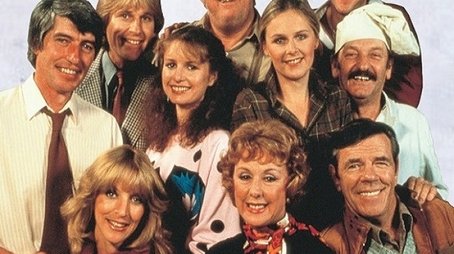
Ask Your Own Question
What is the plot?
A Country Practice begins with the arrival of the new doctor, Paul "Mack" Mackenzie, in the small rural town of Wandin Valley. He is greeted by the local residents, including the kind-hearted nurse, Shirley Gilroy, who quickly becomes a close ally. Mack is introduced to the town's quirky characters, including the local vet, Bob Hatfield, and the town's matriarch, Mrs. Eileen "Eddie" Edwards. The community is warm but has its share of secrets and challenges.
As Mack settles into his role, he faces his first major challenge when a local farmer, Mr. McLeod, suffers a severe injury while working on his property. Mack rushes to the scene, where he finds Mr. McLeod in pain and in need of immediate medical attention. The tension rises as Mack must make quick decisions about how to stabilize Mr. McLeod before transporting him to the hospital. The scene is filled with urgency as Mack works alongside Shirley, showcasing their teamwork and growing bond.
Meanwhile, a subplot unfolds involving Bob Hatfield and his struggles with a difficult relationship with his estranged father. Bob's emotional turmoil is evident as he grapples with feelings of inadequacy and the desire for his father's approval. This personal conflict adds depth to Bob's character and influences his interactions with others in the community.
As the weeks progress, Mack becomes more integrated into the community, attending local events and forming friendships. However, he also faces opposition from some residents who are skeptical of his methods and background. A pivotal moment occurs when a local child falls ill, and Mack's unconventional approach to treatment is questioned. The tension escalates as the townsfolk debate the merits of traditional versus modern medicine, leading to a confrontation between Mack and a few of the more conservative residents.
In a dramatic turn of events, a severe storm hits Wandin Valley, causing widespread damage and isolating the town. The hospital is overwhelmed with patients, and Mack, Shirley, and Bob must work tirelessly to provide care. The storm serves as a catalyst for character development, as the trio faces their fears and insecurities while working together under pressure. The emotional stakes are high as they navigate the chaos, showcasing their resilience and commitment to the community.
As the storm subsides, the aftermath reveals the extent of the damage, both physically and emotionally. The townspeople come together to support one another, highlighting the strong sense of community that defines Wandin Valley. Mack's role as a healer extends beyond the hospital as he helps facilitate recovery efforts, further solidifying his place in the town.
Throughout the series, romantic tensions develop between Mack and Shirley, creating a subplot that adds complexity to their professional relationship. Their chemistry is palpable, but both characters struggle with their feelings, leading to moments of vulnerability and misunderstanding. This romantic tension is interwoven with the main plot, providing emotional depth to their interactions.
As the season progresses, various storylines emerge, including issues of mental health, family dynamics, and the challenges of rural life. Each episode introduces new characters and conflicts, allowing for a rich tapestry of narratives that explore the human experience in a small town. The characters face personal dilemmas that resonate with viewers, creating a sense of empathy and connection.
In the final episodes of the season, a significant crisis arises when a local factory threatens to close, putting many residents out of work. The community rallies together to fight for their livelihoods, showcasing their determination and solidarity. Mack takes a leadership role in organizing efforts to save the factory, demonstrating his commitment to the town and its people.
The season culminates in a dramatic town meeting where residents voice their concerns and propose solutions. Tensions run high as differing opinions clash, but ultimately, the community comes together to support one another. Mack's leadership and compassion shine through, solidifying his status as a beloved figure in Wandin Valley.
As the season concludes, the characters reflect on their growth and the bonds they have formed. Mack and Shirley's relationship reaches a turning point, hinting at future developments. The final scenes capture the essence of life in Wandin Valley, leaving viewers with a sense of hope and anticipation for what lies ahead.
What is the ending?
The ending of "A Country Practice" sees the characters facing various personal challenges and resolutions. The series concludes with a sense of community and connection among the residents of Wandin Valley, highlighting the importance of relationships and support in overcoming life's difficulties.
In the final episodes, the narrative unfolds with a series of poignant moments that encapsulate the essence of the show.
Scene 1: The episode opens in the familiar setting of the Wandin Valley hospital, where the staff is bustling about, tending to patients. The camera pans across the faces of the main characters: Dr. Terence Elliott, the compassionate and dedicated doctor; Nurse Shirley Gilroy, with her warm heart and practical wisdom; and the ever-optimistic veterinarian, Bob Hatfield. Each character is shown in their element, reflecting their growth over the years.
Scene 2: As the day progresses, Dr. Elliott receives news that a beloved member of the community is gravely ill. This news weighs heavily on him, as he reflects on the many lives he has touched throughout his career. The emotional toll of his profession is evident in his furrowed brow and the way he pauses to gather his thoughts before heading to the patient's side.
Scene 3: Meanwhile, Nurse Gilroy is seen organizing a farewell gathering for a long-time resident of Wandin Valley who is moving away. The scene is filled with laughter and nostalgia as townsfolk share stories and reminisce about their shared experiences. The warmth of the community is palpable, and it serves as a reminder of the bonds that have formed over the years.
Scene 4: In a quieter moment, Bob Hatfield is tending to a sick animal, showcasing his deep connection to both his profession and the community. He reflects on his journey and the friendships he has built, particularly with the other main characters. His gentle demeanor and love for animals highlight his nurturing spirit.
Scene 5: As the farewell gathering continues, Dr. Elliott arrives, and the atmosphere shifts to one of bittersweet celebration. He shares heartfelt words about the importance of community and the support they provide each other. The residents listen intently, their faces a mix of joy and sadness as they realize the significance of their shared experiences.
Scene 6: The episode culminates in a poignant moment where the characters gather outside under the stars. They share a toast to friendship, love, and the memories they have created together. The camera captures their smiles, laughter, and the occasional tear, emphasizing the emotional weight of the moment.
Scene 7: As the night draws to a close, the characters reflect on their futures. Dr. Elliott expresses his commitment to continue serving the community, while Nurse Gilroy hints at new adventures ahead. Bob, with a hopeful smile, talks about his plans to expand his veterinary practice, indicating his desire to grow and contribute even more.
Scene 8: The final shot lingers on the group as they stand together, united in their shared journey. The screen fades to black, leaving viewers with a sense of closure and the enduring spirit of Wandin Valley.
In this ending, each character finds a resolution that aligns with their personal growth and the relationships they have built. The series concludes with a celebration of community, love, and the importance of supporting one another through life's challenges, encapsulating the heart of "A Country Practice."
Is there a post-credit scene?
"A Country Practice," which aired from 1981, does not feature post-credit scenes. The show typically concluded with a final scene that wrapped up the episode's storylines, often leaving viewers with a sense of closure or a light-hearted moment. The format focused on the lives of the characters in the small town of Wandin Valley, emphasizing their relationships and the challenges they faced, rather than incorporating additional scenes after the credits. Each episode would end with a poignant or humorous note, reflecting the show's blend of drama and comedy, but there were no additional scenes following the credits.
What are the main character's motivations in the relationship between Paul and Lucy?
Paul and Lucy's relationship is marked by a deep emotional connection that evolves throughout the series. Paul, a dedicated doctor, often struggles with the demands of his profession and his feelings for Lucy, who is portrayed as a strong and independent woman. Their motivations are rooted in a desire for companionship and understanding, but they also face external pressures, such as career aspirations and personal insecurities, which complicate their bond.
How does the character of Bob Hatfield contribute to the community dynamics in Wandin Valley?
Bob Hatfield, the local farmer, serves as a pivotal character in A Country Practice, embodying the spirit of the rural community. His interactions with other characters often reflect the challenges of rural life, including financial struggles and the importance of community support. Bob's motivations stem from a desire to protect his family and land, and his relationships with other townsfolk reveal the interconnectedness of their lives, showcasing both the joys and hardships of country living.
What challenges does the character of Shirley Gilroy face in her role as a nurse?
Shirley Gilroy, as a nurse, faces numerous challenges that highlight her dedication and resilience. She often juggles the demands of her job with her personal life, including her relationships and family responsibilities. Her motivations are driven by a strong sense of duty to her patients and a desire to make a difference in their lives. Throughout the series, Shirley's emotional struggles, such as dealing with loss and the pressures of the healthcare system, add depth to her character and illustrate the complexities of her role.
How does the arrival of new characters impact the existing relationships in Wandin Valley?
The arrival of new characters in A Country Practice often serves as a catalyst for change within the established relationships in Wandin Valley. For instance, when a new doctor or nurse joins the practice, it can create tension or rivalry with existing staff, such as Paul or Shirley. These dynamics lead to emotional conflicts, jealousy, and sometimes unexpected alliances, as characters navigate their feelings and adapt to the new social landscape. The impact of these arrivals is felt not only in professional settings but also in personal relationships, as characters reassess their connections and priorities.
What significant events lead to character development for the character of Frank Gilroy?
Frank Gilroy's character development is significantly influenced by various events throughout the series, including personal losses, health crises, and family dynamics. One pivotal moment is when he faces a serious health scare, prompting him to reevaluate his life choices and relationships. This experience leads to a deeper understanding of his role as a father and husband, as he grapples with feelings of vulnerability and the desire to be a better man. Frank's journey is marked by moments of introspection and growth, showcasing the emotional weight of his experiences and their impact on his relationships with his family and the community.
Is this family friendly?
"A Country Practice," produced in 1981, is generally considered family-friendly, but it does contain some themes and scenes that may be potentially objectionable or upsetting for children or sensitive viewers. Here are a few aspects to consider:
-
Medical Emergencies: The show often depicts medical situations, including surgeries and emergencies, which may be distressing for younger viewers. The portrayal of illness and injury can evoke strong emotions.
-
Death and Grief: Characters occasionally deal with loss, including the death of loved ones. These storylines explore themes of grief and mourning, which may be heavy for some audiences.
-
Relationship Struggles: The series includes various relationship dynamics, including marital issues and breakups. These situations can lead to emotional conflict and may be difficult for younger viewers to understand.
-
Social Issues: The show addresses social issues such as mental health, addiction, and domestic violence. While these topics are handled with sensitivity, they may still be challenging for some viewers.
-
Conflict and Tension: There are moments of conflict between characters, which can lead to emotional confrontations. The tension in these scenes may be unsettling for sensitive viewers.
Overall, while "A Country Practice" is designed to be accessible to a wide audience, parents may want to preview episodes to gauge their suitability for younger viewers.











